Delta Electronics, Inc. was founded in 1971 as a leading producer of switching power supplies and ventilation products. Delta has been focusing on innovation of new technology and services, ranging from IT to ET. The sales services include total solution of power management, digital projection, industrial automation, networking and renewable energy sources. Delta's core value is to provide innovative, clean, and efficient energy solutions and services to the world.

Delta's large outdoor billboard display (Tianmu Baseball Stadium)
Delta hosts 40th Anniversary Technology Symposium: going green
Delta hosted the 40th Anniversary Technology Forum and invited industry elites from all over the world to discuss renewable energy and highly-efficient power management systems. Delta also showcased their products and technologies in solar, wind power, electric cars, e-paper, LED lighting, and green buildings .

Delta's 40th Anniversary Technology Forum
Vision and goals: conservation, renewable energy source, and development of green buildings
In his speech, Bruce Cheng, chairman of Delta, especially acknowledged the contribution made by Kwoh-Ting Li, founder of Hsinchu Industrial Park, and Sun Yun-suan, former minister of economic affairs, for developing Taiwan's industries and economy. "It is due to their efforts that Delta can achieve so much today," said Cheng.

Bruce Cheng, chairman of Delta
In the initial period, Delta mainly produced components. In later times, Delta began to develop switching power supplies with the objectives to adopt renewable energy sources while achieving conservation. Also, Delta has an aim to develop green buildings by maximizing the use of energy without wastes.

Dr. RC Liang, chairman and CEO of Delsolar Corp.
Session 1: clean and renewable energy solutions with keynote speech on megatrend energy: the fuel cell as a central element of future energy management
Dr. Dietmar Bender, vice president of Strategy and Technology Inorganics Division, BASF Corp., stated 70% of electricity in the world comes from fossil fuels (such as coal, crude oil, and natural gas) and these energy sources are limited; therefore, the world needs to adopt clean and renewable energy sources. To achieve the goal set by the European Union to lower carbon emissions, 75% of the electricity produced by all power plants in the world should use renewable energy sources.
BASF has been focusing on the development of components required for high temperature polymer electrolyte membrane fuel cells (HT-PEMFC), including celtec-MEA, and reformer catalysts. Although the cost for fuel cells remains high, the cooperation with Delta will speed up the commercialization of this product.
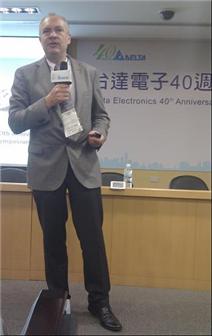
Dr. Dietmar Bender, vice president of Strategy and Technology Inorganics Division, BASF Corp.
Photovoltaics- electric power from the sun: past, present, and future
Harold Hovel, research staff member of IBM Corp., mentioned that there are six types of materials used by solar cells (list by conversion efficiencies from low to high): thin-film (non-silicon, non-tandem amorphous silicon, and non-CZTS), thin-film (CIGS and CdTe types), polycrystalline silicon, monocrystalline silicon, multi-layer structure (single light source), and multi-layer structure (multiple light sources). The conversion efficiency of each type is 14%, 20%, 20%, 24%, 35%, and 41.5% respectively. In addition, thin-film cells (CIGS, CdTe types) are the most cost effective solar cells.
Mr. Hovel stated three possible directions for the future of photovoltaic technology.
1. The solar cell with the most abundant resources is more likely to become the mainstream of the solar industry.
2. The solar cell with the lowest cost also has the possibility to become the mainstream, but conversion efficiency would be a concern.
3. The adoption of nano technology to increase conversion efficiencies.
The common knowledge of the industry is to choose the technology that is most cost-effective and develop materials that can achieve the highest efficiency.
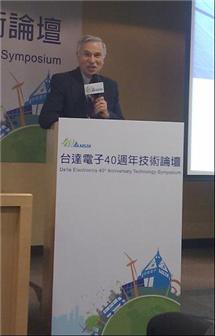
Harold Hovel, research staff member of IBM Corp.
Panel discussion - clean and renewable energy solutions
Dr. Charles Tsai from Delta Electronics acted as the coordinator with panelists Dr. Hsin-Sen Chu, executive vice president of ITRI; Mr. Chao-Chih Lien, CEO of TECO; Dr. Tso Chunto, director of TIER; Dr. Fred Lee, professor from Virginia Tech. Univ.; Dr. Qing Chen from Delta Electronics; and Dr. RC Liang, chairman and CEO of Delsolar Corp., to discuss clean and renewable energy solutions.
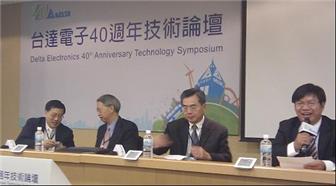
Panelists (left to right): Dr. RC Liang, Dr. Tso Chunto, Dr. Fred Lee, Dr. Charles Tsai
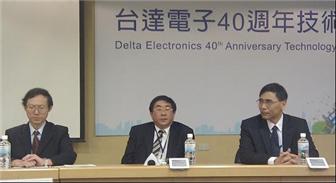
Panelists (left to right): Dr. Hsin-Sen Chu, Mr. Chao-Chih Lien, and Dr. Qing Chen
The industry has been focusing on increasing conversion efficiency for solar cells to reach the goal of US$1/watt. In the future, the goal is US$0.5/watt. China has been emphasizing on the importance and development of renewable energies by highlighting wind power, solar, LED and electric vehicles in the 12th Five-year Plan.
Session 2: green applications and networking with keynote speech: growth prospects and future outlook for the electronic paper business
Mr. Masahiro Higashi, director of Advanced Business Development Division and general m anager of Electronic Paper Business Planning and Sales Department, Bridgestone Corporation, explained the strength and specifics of Bridgestone' s e-paper device.
Bridgestone, the tire manufacturer, began its development of the technology for e-paper back in 2000. The fruit of the labor, AeroBee incorporates the quick response liquid powder display (QR-LPD) patented display technology. This technology can be used by electric shelf labels (ESL), e -book readers, watches, mobile phones, digital frames, and electric billboards.
QR-LPD has rapid reactions with characteristics of paper-like visual effects, bi-stable display technology, wide angle, low temperature, and bendable. Delta has been working with Bridgestone to develop applications for the devices. Delta announced in November 2010 to cooperate with Bridgestone to develop the latest generation of AeroBee e-paper modules.
Delta launched the new colored e-book with Vivitek in CES 2011 to promote QR-LPD technology to the customers. The application devices for QR-LPD include 2- and 4-inch ESL, and 8-and 13-inch e-book readers.
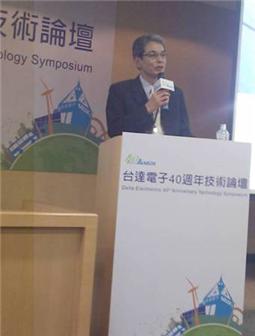
Mr. Masahiro Higashi, director of Advanced Business Development Division and general manager of Electronic Paper Business Planning and Sales Department, Bridgestone Corporation
Green applications and networking @ Delta
a. E-paper
According to Dr. Chan Wang from Delta, E Ink, SiPix, and Bridgestone all have electrophoretic display technology. E Ink and SiPix respectively use microcapsule and microcup technology, which use liquid as the electrophoresis media. However, Bridgestone adopts microbox technology that uses air as media. The e-turn state of air as media is "flying," the reaction speed is faster than "swimming," which is what liquid does. This is one of the advantages to adopt QR-LPD which uses microbox technology.
In addition, Delta also developed "meeting room reservation system display" technology to display and update schedules through wireless transfer. This reduces the need for door and name plates.
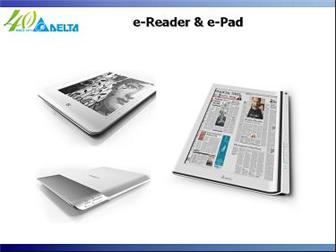
Delta's e-paper device
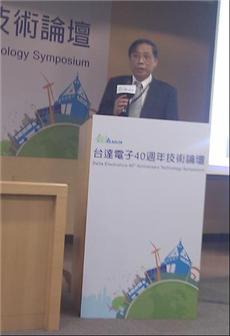
Dr. Chan Wang from Delta
b. Display Solutions Business Unit
Mr. Charlie Pai from Delta's Display Solutions Business Unit (DSBU) marketing and business development introduced DSBU's products such as digital and high definition projectors, video and LED wall, and LCD public display. Take projectors for example, Delta's LED portable projector can be carried around and uphold by a single hand.
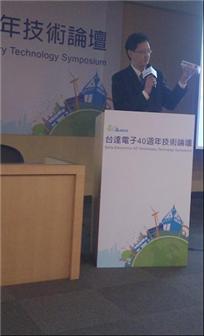
Mr. Charlie Pai from Delta's Display Solutions Business Unit (DSBU) marketing and business development holding Delta's LED portable projector
The location for the application of these products includes offices (presentation), households (home theater), classrooms (interactive whiteboard), control centers and stadiums (billboards and LED billboards). The application can even extend to movie theaters (3D movies), outdoor arenas (4D experience by high lumen projectors), art performances (mobile stages), and exhibition halls (interactive experience)…etc.
c. Networking
Dr. YY Tsai, CTO of Delta Networks, Inc. , pointed out the evolution from repeater and hub in the 1980s, to bridge and layer 2/3 switch, to TOR switch of present day shows the growing importance of Ethernet switches.
Internet connection evolved from narrowband to wideband, and will enter the generation of optical fiber. Wireless networking products also developed from 802.11 abgn (personal and business use) to 802.16d (fixed WiMAX) and 16e (mobile WiMAX), Femtocell and 4G LTE. This shows the rapid evolution of the networking generation. DNI has a full line of products to serve the needs for different Internet generations.
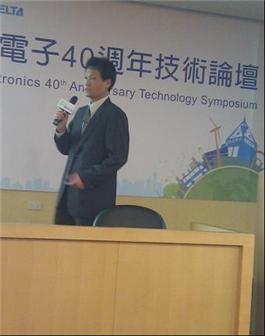
Dr. YY Tsai, CTO of Delta Networks, Inc.
d. Healthy and comfortable new lighting solutions
Mr. Roland Chiang from Delta's Solid Lighting Business Unit (SLBU) stated the Japanese earthquake caused shortage of electricity, which raised awareness of energy conservation in Japan. This increased Japan's demand for LED light bulbs. According to Nikkei, LED light bulbs only consume 1/7 of energy compare d to incandescent light bulbs with longer lasting life. The high price of LED light bulbs (around JPY2,000) previously kept their penetration rate to 20% only. The penetration rate has increas ed to 25% since the earthquake. In addition to LED light bulbs, Delta also produces street lightings that fit the standards set by Illuminating Engineering Society of North America (IESNA).
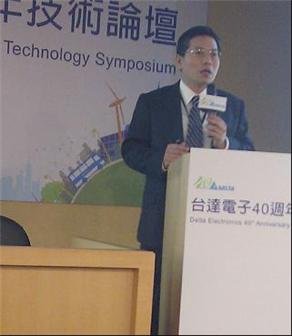
Mr. Roland Chiang from Delta's Solid Lighting Business Unit (SLBU)
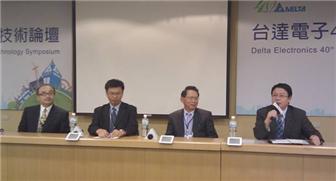
Panelists (left to right): Dr. Bou Chung Lin, Mr. Yu-Min Peng, Mr. Sam Liang, and Mr. Victor Cheng.
Panel discussion: green applications and networking
Mr. Victor Cheng, chairman & CEO of Delta Networks, Inc., coordinated with Mr. Sam Liang, consultant of Delta Electronics; Mr. Yu-Min Peng, deputy director of Material and Chemical Research Laboratories in ITRI; and Dr. Bou Chung Lin, general manager of Marvell Taiwan Operations, as guest speakers for the discussion.
During the discussion, the effect of new IT/ 3C products mentioned such as e-papers/e-book readers, tablet PCs, smartphones, PCs, and TVs on wideband Internet and electricity. The trend has been moving from WWW (World-wide Web) to MMM (Multi-media Mobility).
Most end devices have been shifting toward being "smart" and cloud application has been increasing in popularity. Furthermore, popular smart devices have been aggressively entering the living room market and industry expects by end of 2011 there will be TV products with iPad-like functions (such as Samsung's Smart TV).
Session 3: high efficiency power management with keynote speech: renewable energy and nano grid
Dr. Fred Lee, professor from Virginia Polytechnic Institute and State University, explained in the speech that the power supplies, including front-end converters, which are divided into bronze, silver, gold, and platinum, can have conversion efficiency above 90%.
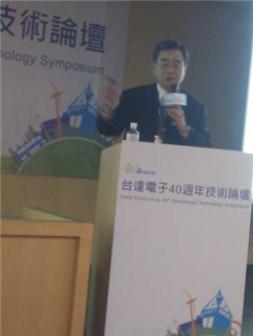
Dr. Fred Lee, professor from Virginia Polytechnic Institute and State University
The trend of the system has been shifting from centralized to diversified power supply structure. Designs can also be customized with module blocks including EMI filter, boost PFC, DCX, and buck regulator. The main board can also adopt diversified design to simplify the structure.
Standard SO-8 package uses plastic, and therefore the heat transfer at the top of the package is sufficient. Due to increasing demand for current density, new type of packaging technology has been developed. International Rectifier developed the DirectFED packaging technology which is more effective than loss-free package (LFPAK). DirectFET structure can easily replace two parallel SO-8 packaging even without topside cooling.
According to Dr. Lee, the vision of Center of Power Electronics Systems in Virginia Tech is to develop power supply solution with the highest value with research and academic institutions around the world because of Earth's limited resources.
In the future electricity system, the concept of micro grid will be incepted in the distribution of electricity that can include power plants using renewable energy source into the community power supply system. In the future, every household can have its own power system (solar or wind power) and become part of the nanogrid. Unused electricity can be provided to other users in an interactive way.
High efficiency power management @ Delta
a. The trend for power IC designs
Dr. Wei-Chan Hsu, senior VP R&D for NEM, explained the two main functions of power ICs: one is to convert and save electricity when charging (rechargeable batteries), the other function is to effectively release electricity when being used to keep the life span of the batteries longer.
Power IC will play an important role in medical care in the future especially the micro energy harvesting devices. Furthermore, the power management function has become a requirement for system-on-a-chip (SoC) and power management structure has been shifting into digital electronics from the traditional analog type of electronics.
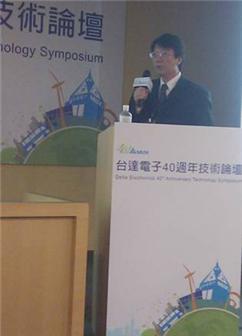
Dr. Wei-Chan Hsu, senior VP R&D for NEM
b. The new concept of motor drives
Dr. David Tsai of Delta Electronics indicated that motor drives use motors to make mechanical box move to achieve automation. During motion, there will be problems of uncertainty derived from transmission and cause vibration. The vibration will increase over motion time to create more uncertainties. Therefore, a mechanism needs to be developed to decrease the uncertainty caused by vibration.
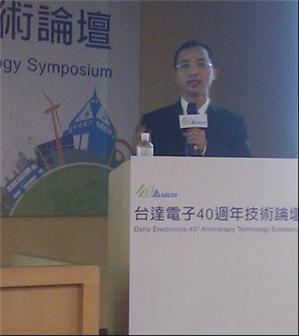
Dr. David Tsai of Delta Electronics
Motor drive not only has the drive but also the diagnostic function to monitor all brakes. This is called "Smart Drive," which adopts continuous shifted transform (CST) technology developed by Delta that is superior to descrete fourier transform (DFT) and fast fourier transform (FFT).
Panel discussion: high efficiency power management and Taiwan 's competitiveness
The coordinator, Dr. Jackson Hu, chairman & CEO of NEM, invited Dr. Chern-lin Chen, professor from National Taiwan University; Dr. Fred Lee, professor from Virginia Tech. Univ.; Mr. George Liu, director of Power and MEMS Business Development in TSMC; and Dr. Larry Tu, vice president of Engineering Service in Vanguard, to join the discussion.
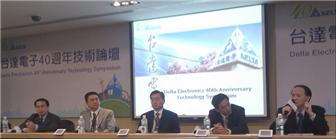
Panelist (left to right): Dr. Larry Tu, Mr. George Liu, Dr. Fred Lee, Dr. Chern-lin Chen, and Dr. Jackson Hu.
For Delta, power management is effective when 5-20% of energy has been saved. For the current market, power management is in the hands of systems, and the room for improvement on the equipment end has been limited. Therefore, the focus now should be to increase the efficiency with cooperation between different industries.
Delta is currently the world's largest ODM power supply firm with over 25 million units of shipment every month. There are three R&D facilities around the world, nine engineering design center, and in total of more than 2,300 engineers.
Delta's energy supply products have the world's largest market share since 2006 for PCs, notebooks, servers, work stations, gaming devices, printers, and LCD TVs. Overall, the total revenues of Delta's commercial power supply products was ranked first place in 2010.
Closing Remark
Mr. Yancey Hai, CEO and spokesperson of Delta, stated in the closing remark that the vision of Delta is "to provide innovative, clean and efficient energy solutions for a better tomorrow" and Delta has been actualizing this vision. From today's forum, it proves Delta's determination to continue contributing to achieve our vision.
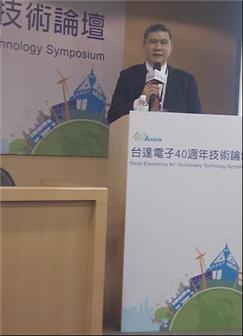
Mr. Yancey Hai, CEO and spokesperson of Delta



